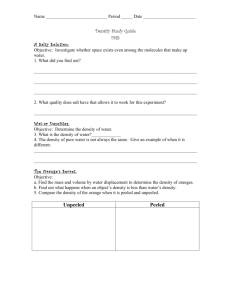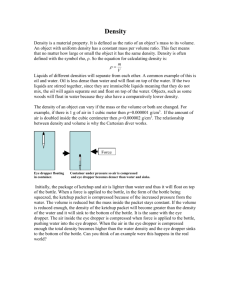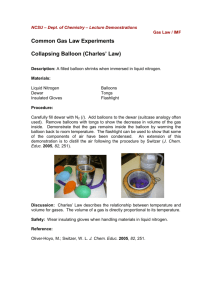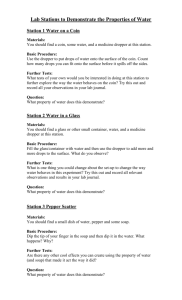Cartesian Divers
advertisement
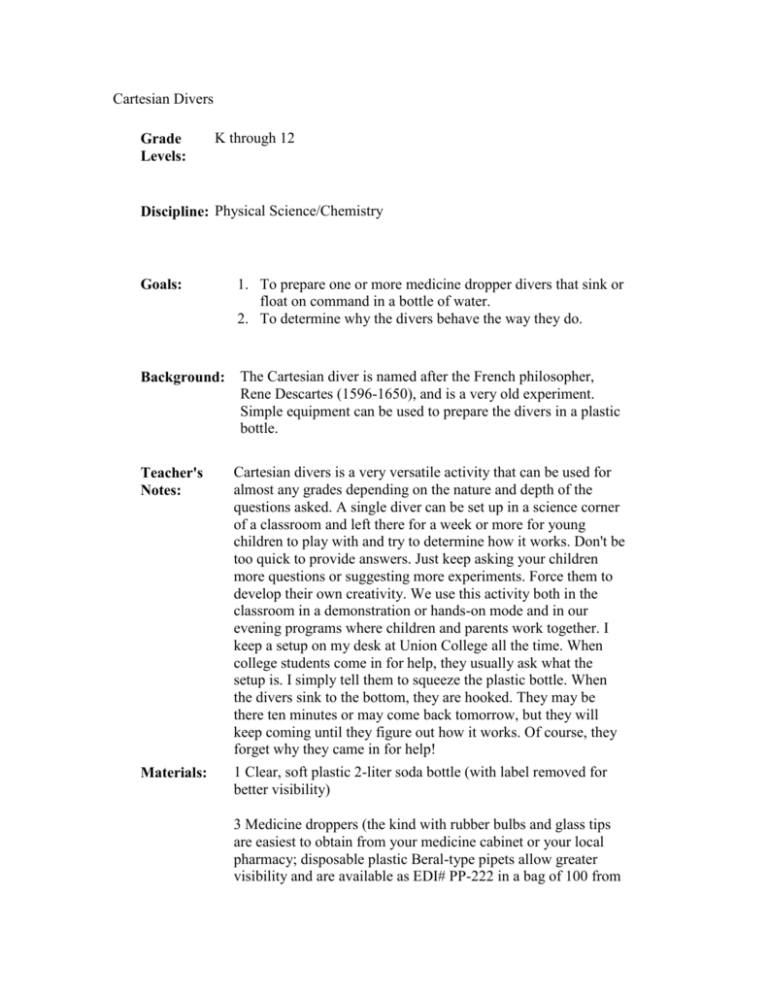
Cartesian Divers Grade Levels: K through 12 Discipline: Physical Science/Chemistry Goals: 1. To prepare one or more medicine dropper divers that sink or float on command in a bottle of water. 2. To determine why the divers behave the way they do. Background: The Cartesian diver is named after the French philosopher, Rene Descartes (1596-1650), and is a very old experiment. Simple equipment can be used to prepare the divers in a plastic bottle. Teacher's Notes: Cartesian divers is a very versatile activity that can be used for almost any grades depending on the nature and depth of the questions asked. A single diver can be set up in a science corner of a classroom and left there for a week or more for young children to play with and try to determine how it works. Don't be too quick to provide answers. Just keep asking your children more questions or suggesting more experiments. Force them to develop their own creativity. We use this activity both in the classroom in a demonstration or hands-on mode and in our evening programs where children and parents work together. I keep a setup on my desk at Union College all the time. When college students come in for help, they usually ask what the setup is. I simply tell them to squeeze the plastic bottle. When the divers sink to the bottom, they are hooked. They may be there ten minutes or may come back tomorrow, but they will keep coming until they figure out how it works. Of course, they forget why they came in for help! Materials: 1 Clear, soft plastic 2-liter soda bottle (with label removed for better visibility) 3 Medicine droppers (the kind with rubber bulbs and glass tips are easiest to obtain from your medicine cabinet or your local pharmacy; disposable plastic Beral-type pipets allow greater visibility and are available as EDI# PP-222 in a bag of 100 from Educational Innovations, 151 River Road, Cos Cob, CT 06807 and from other sources) 3 Hex nuts (only if plastic pipets are used; brass that doesn't rust with threads that can screw securely onto the stem of a plastic pipet; obtainable from your local hardware store) 1 Plastic cup (a 16-oz cup from a fast-food restaurant works well; a cut-off 2-liter soda bottle or a large paper soda or milk shake cup can also be used; the cup must be at least twice as deep as the droppers are long so that you can partially fill the droppers with water and determine whether they float) 1 Waterproof tray in which to work 1 Pair of 4-inch tweezers Water Explanation: If a diver has a greater density than liquid water, the diver will sink. If the diver has a lesser density than liquid water, the diver will float. Thus, all forms of this experiment require changing the density of the diver. Density equals mass divided by volume or the ratio of mass to volume. Thus, you can increase the density of a diver by adding mass without changing its volume or by decreasing the diver's volume without changing its mass. Of course, the reverse also holds. The experiments discussed here change the mass of the diver while keeping its volume constant. A gas sample is compressed into a smaller volume as the pressure on the gas is increased and vice versa, if the temperature remains constant. Some of you remember this as Boyle Õs law. Gases are compressible, but liquids and solids are not. Therefore, as you squeeze the soda bottle, the pressure is transferred from your hand to the water and from the water to the air trapped inside the diver. As the pressure on the air increases and the volume of air in the diver gets smaller, more water enters the diver, making it heavier and less buoyant, with the result that the diver sinks to the bottom. Conversely, as the pressure is released, the air inside the diver expands and increases the buoyancy so that the diver rises to the surface. In order to cause droppers to dive in succession, you must prepare divers of gradually decreasing density or gradually decreasing amounts of water in the divers initially. Thus, successive divers require stronger squeezing of the bottle to make them dive. When you release your squeeze, they rise in the reverse order from which they dove, namely, the last to dive comes up first. This occurs because the last to dive initially had more air and less water in it and is more buoyant. Thus, it will rise first. If there is considerable air in the soda bottle when the dropper is added, it will be more difficult to make the dropper dive. You will need to squeeze the bottle much harder because you have to compress both the air inside the bottle and the air inside the dropper. You may have to add more water to the dropper to be able to make it dive at all. If hot water is used in the soda bottle, it will also be more difficult to make the dropper dive. You will need to squeeze the bottle much harder because a higher temperature heats the air inside the dropper and makes it expand and makes it more difficult to compress. Again you may have to add more water to the dropper to be able to make it dive at all. A number of things can be tried to cause a sunken diver to rise to the surface. One must either decrease the density of the dropper or increase the density of the surrounding water. One way of decreasing the density of the dropper is to decrease the pressure in the bottle. This can be accomplished by removing the cap, pressing the soda bottle slightly with your hands, and simultaneously screwing the cap back on tightly. When you release your squeeze, the pressure in the bottle and on the air in the dropper is decreased, some water leaves the dropper, and it becomes more buoyant and rises to the surface. As soon as you open the bottle again, and increase the pressure in the bottle, the diver sinks. Removing the cap, heating the bottle in a hot water bath, and replacing the cap also reduces the pressure in the bottle because the pressure of the little air at the top decreases as the bottle cools. This causes the sunken diver to rise.One way to increase the density of the surrounding water is to add several tablespoons of table salt (sodium chloride) to the water in the bottle and shaking it to dissolve the salt. The dropper initially rises though it may eventually sink on standing because the more dense salt water also gets into the dropper and increases its density as well. There may also be other methods for causing a sunken diver to rise. Send your suggestions so that I can test them and share them with others. In liquids of lower density such as rubbing alcohol or cooking oil are used in the bottle, the empty dropper itself will not float as high in the liquid because its density is relatively higher in the new liquid compared to water. Not as much liquid will be required to compress the air in the dropper sufficiently to cause it to barely float. However, because of the lesser density of the liquid, the buoyancy of the dropper will not be as sensitive to pressure changes as it was with water. Thus, you may have to squeeze harder to get the dropper to dive. Questions: 1. How does the diver's behavior apply to your trying to float motionless on your back (what some refer to as the dead-man's float)? Your task in order to float motionless is to decrease your density as much as possible to cause your body to float sufficiently high in the water that you can breathe easily. This can be accomplished by either reducing your mass or increasing your volume. Unlike the diver we normally reduce our density by increasing our volume in the process of keeping our lungs as full of air as possible. Think about how you are taught to breathe in order to float motionless. Breathe in quickly and deeply, hold it for a reasonable length of time, breathe out quickly, then immediately breathe back in quickly and deeply again, then repeat the process over and over. Nobody will sink using this breathing technique. Why is it important? You want to keep your lung cavity full as much of the time as possible. If you breathe out slowly and completely, your feet start toward the bottom, then your knees, and soon your whole body is headed down. Only by taking a very deep breath or by arm or leg movements can you gain stability on the surface again. Thus, just as for the diver, we need to reduce our density to less than that of water in order to stay afloat; otherwise we sink. Our density without air in our lungs is slightly greater than that of water. It also helps to extend our arms high above our head as we stretch out on the water so that our lung cavity is then nearly centered in our body. Some of these explanations may be beyond your comprehension and the comprehension of your students. DonÕt worry about that. We as teachers pride ourselves too much in being able to give explanations. We really need to work much harder at stimulation and less on explanation. Remember that it is much more important to get children involved in doing activities, making observations, and thinking about their results and reasons for them than it is to pump them full of conceptual knowledge. Put simply, we need to concentrate more on getting them excited about learning and teaching them how to learn rather than shoveling in facts. Procedure: PREPARING FOR THE EXPERIMENT A plastic Beral-type pipet is too light for this experiment, and mass must be added. If a plastic pipet is used, cut off all but 15 millimeters of the pipet stem with scissors. Then screw the brass hex nut onto the shortened stem to add mass. The nut will make its own threads. For young children up to about fourth grade I prepare the plastic pipets ahead of time. You draw water into either kind of dropper by squeezing some air out of the rubber or plastic bulb, placing the tip of the dropper under the surface of water in the plastic cup, and releasing your squeeze slowly to let water into the dropper. You let water out of the dropper by gradually squeezing the rubber or plastic bulb. PERFORMING THE EXPERIMENT Work over the waterproof tray at all times. Prepare one or more medicine dropper divers by the following procedure. Nearly fill the plastic cup with water, and place the dropper in the water. Note that it floats easily in a nearly upright position. Squeeze some of the air out of the dropper, and draw water from the cup into the dropper until the dropper is approximately half-full. Then place the dropper back into the plastic cup of water to determine whether it sinks or floats. Repeat this process, and by trial and error draw sufficient water into the dropper until it just floats. If you draw in too much water, the dropper will sink, and you will have to let some water out of the dropper. If you draw in too little water, the dropper floats, but well above the surface of the water, and you will have to draw more water into the dropper. You may have to tip the water back into the bulb of the pipet before squeezing out air and drawing in more water. Young children will need some help. When properly adjusted, the top of the dropper bulb should float either at or barely above the surface of the water (that is, the density of the diver should be just slightly less than the density of water). If it floats too high, children, at least, will not be able to make it dive later because the pressure developed from their squeezing the bottle will not be great enough. Some people like to use a pump designed to keep the carbonation in 1- and 2-liter soda bottles and available in your local grocery store. Then even small children can easily operate the divers. I think that it is more instructional for the children to adjust the droppers carefully in the first place. Fill the plastic 2-liter soda bottle to its narrow neck with cold water from the faucet. Place your diver carefully into the soda bottle (it should float as it did in the cup). Place the cap on the soda bottle, and screw it down tightly. Command the dropper to 'dive', squeezing the sides of the soda bottle with considerable force as you say the word. Did it dive? Command the dropper to 'rise' to the surface as you release your squeeze. Did it rise? Why did the diver behave as it did? If the dropper did not dive properly, remove the cap from the soda bottle, squeeze the open soda bottle just enough to raise your diver into the narrow neck from which you can remove it with the tweezers. Be careful not to spill water. Add more water from the cup into the diver (that is, repeat the water level adjustment of three paragraphs above), and then place it back in the soda bottle and try again. Did it dive and rise? Why did the diver behave as it did? MODIFICATIONS TO THE EXPERIMENT Remove the dropper from the soda bottle as described in the previous paragraph. Prepare several dropper divers numbered 1, 2, and 3 so that on command the first one will dive, then the second one, and then the third one in succession. What is the secret in causing this to happen? Do they rise on the surface in the same order or in the reverse order? Why? Remove the droppers as described earlier. Pour about one-quarter of the water out of the soda bottle, and repeat the diving process with one diver that worked well when the soda bottle was full. If there is more air in the soda bottle and less water, is it easier or harder to make the dropper dive? Do you have any idea why? Remove the dropper as described earlier. Replace the cold water in the soda bottle with hot water (not dangerously hot) up to the neck as in the first trial. Repeat the diving process. Does the dropper dive more easily or less easily with hot water rather than cold water in the soda bottle? Do you have any idea why? Remove the dropper as described earlier. Adjust the water in the dropper so that the diver barely sinks in the plastic cup. Put the dropper back into the plastic soda bottle where it should also sink. Then devise a way to make the dropper rise to the surface of the water. Pouring the water out of the bottle is not an allowed method! Did you find a method that works? Why did that method work? Remove the dropper as described earlier. Try the experiment using a different liquid having a different density from that of water. Rubbing alcohol or cooking oil can be used, but more liquid is required than may be worth the learning involved. Both have lower densities than water. Remember to partially fill the dropper with that liquid also. Does the dropper dive more easily or less easily with a different liquid in the soda bottle? Do you have any idea why? Do you need to have more liquid or less liquid in the dropper in order to make it dive and rise properly? Why? Additional variations of this experiment that provide considerably more challenge, especially if used with middle- or high-school students or if a student is setting up this experiment as a science fair project. makes one diver go down and retrieve another that has sunk; makes a diver spin as it dives and rises using an attached pinwheel; makes closed-system divers that change their shape with pressure changes rather than taking in or letting out water; suspends divers at different levels in a density gradient column; makes divers controlled from remote locations using pressure or chemical reactions; makes divers see-saw; makes concentric divers where a small one dives in a larger one and the large one dives in the bottle; and makes an electric diver that lights a light or rings a bell as it dives. This list of variations has been presented with the intention of demonstrating the versatility and expandability of a concept that many have considered already exhausted. From buoyancy to pressure to surface tension to density to chemical reactions to electrical conductivity, the Cartesian diver seems to be unlimited as a springboard... for a variety of fun and exciting educational activities." (1) The sky is the limit if you use your imagination. Now go to the kitchen, and try your hand at some of these. Please share any additional ideas that you dream up with your fellow teachers.
